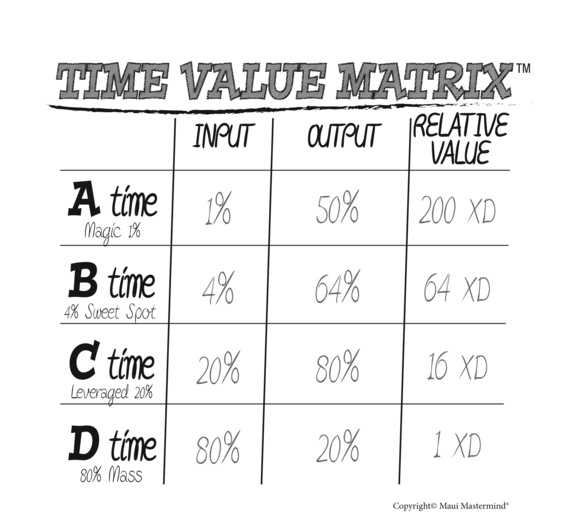If 20 years of coaching business owners to grow their companies has taught me anything, it's this: The average business owner is overworked, stressed out and feels pulled in 20 directions all at once.
Most of all they're frustrated. Frustrated that they have too many lower value tasks that clutter up their day and make it difficult to focus on those fewer, better things that potentially create the most value for their company.
Sadly, their "solution" is simply to work harder. They increase their hours, work at night and over the weekend. But all this just helps them maintain the status quo, not get ahead.
I want to let you in on a little secret. Working harder is not the answer. It will not get you the results you crave. In fact, the harder you work, chances are the less you'll accomplish that really matters. I know this sounds easy for me to say, but hang in there with me as I walk through a key concept with you.
You've likely heard of "Pareto's Principle", which states that 80 percent of your efforts produce 20 percent of your results, and that 20 percent of your effort produces 80 percent of your results. Well if this is true (and my experience shows me that it is), then let's apply this concept more rigorously.
If you take that 20 percent of your actions that generate 80 percent of your results and apply the same distinction, then 20 percent of that 20 percent produces 80 percent of 80 percent of your results. That means that 4 percent of your effort (the 20 percent of 20 percent) generates 64 percent of your results.
And if you can bear with me for another math moment, apply this distinction one more time.
This means that 1 percent (20 percent of 20 percent of 20 percent) generates 50 percent of your results! Think about it -- 1 percent of your highest leverage work produces 50 percent of all your results!
We use this concept to create the Time Value Matrix (see image below), which is an actual tool my team and I created for our business coaching clients to help them quickly and accurately break their activities down into these four distinct categories of time: A Time, B Time, C Time and D Time.
D time is the 80 percent of unleveraged, wasteful time that only produces 20 percent of your total return. I call this time the "80 Percent Mass". These are the low value activities that don't add value and should be deleted, delegated, delayed, or designed out of occurring in the first place.
C time is the leveraged 20 percent that produces 80 percent of your results. I call this time "Leveraged Time". These are the activities that do produce value, but generally the value they produce just maintains your status quo, not gets you ahead.
Now for most people this is the only distinction they have ever made about time. They may call it "billable" vs "non-billable" time, or some other name. And while it's better than most people have, if this is your only distinction on time, you are never going to earn what you are capable of earning, both in terms of income or net worth.
Next there is B time. This is the highly focused 4 percent that generates 64 percent of your results. I call this time the "4 percent Sweet Spot". These activities create a magnitude more value than those C time activities.
And finally, there is the top of the pyramid -- A time -- the "Magic 1 Percent". Fully 50 percent of your results come from these activities. These activities may only take an hour or two, but they produce miracles for your company.
Did you know that most people not only have no idea what activities fall into the above four categories, but they don't even know they exist? How in the world can you create more A and B time if you don't know what activities constitute A and B time for you?
When you really get this distinction and shift your focus from "putting in hours" to upgrading the type of work you do (more A and B time, and less D time) in the hours you do work, the results are amazing.
Let me share an example with you. Imagine you are an attorney who charges $300 an hour. What would your D time activities be? Things like fixing a computer glitch, or making copies, or sorting out mail, or any of the things you do that you cannot bill a client for. What should you do with these activities? Delay them, delegate them, or dump them. You simply cannot afford to do them yourself.
What would your "C time" activities be? Anything that is billable time for you. This could include working on a legal brief, or reviewing a contract, or updating a client.
Understand this: C time can provide you with a great income, but you will always have to work exceptionally hard to earn it. This is the trap that catches most high income professionals. They seek to increase their earnings by cranking out more hours. Mistake! More hours will only take you so far.
The answer lies in A and B time.
B time for this attorney might include building relationships with other professionals who refer over business. Or putting systems in place in their law firm so that their staff can get better results without needing so much of our fictional attorney's time. It might also include creating an accounts receivable system that increases the collection on all the firm's billings by 10 percent. You get the idea.
What would A time look like? This could be speaking at a large conference where this attorney is able to generate new client relationships for his or her firm that are worth hundreds of thousands of dollars of billable services. Or it could be writing a book that can be used to generate new business for the firm.
See the difference yet? D time is by definition something that you should get off your plate. C time is time that you do your work more effectively. A and B time, however, are when you step out of the "doing-ness" of the work and do something that improves your capacity to create results, or significantly pushes back your limiting factor (e.g. generating new clients, improving a critical system, etc.)
In fact, by focusing on upgrading your use of time instead of focusing on increasing your hours worked, you can often double or triple your income, while at the same time lowering your working hours.
Here are the real questions for you:
What activities do you do that fit into each of the four time categories above?
What are your D activities?
What are your C activities?
What are your B activities?
What are you're A activities?
The first step to upgrading your use of time is to clearly identify--in writing--what you do that truly creates value (and what you do that doesn't.)
If you want to read more about how to get more done with less time, here is a link to a much longer article (roughly 3,000 words) I wrote on exactly this subject that goes into greater detail.
At the very least, take the all important first step of listing out you're A, B, C, and D time activities.
For more ideas on growing your business, including a free tool kit with 21 in-depth video trainings to help you scale your business and get your life back, click here.

